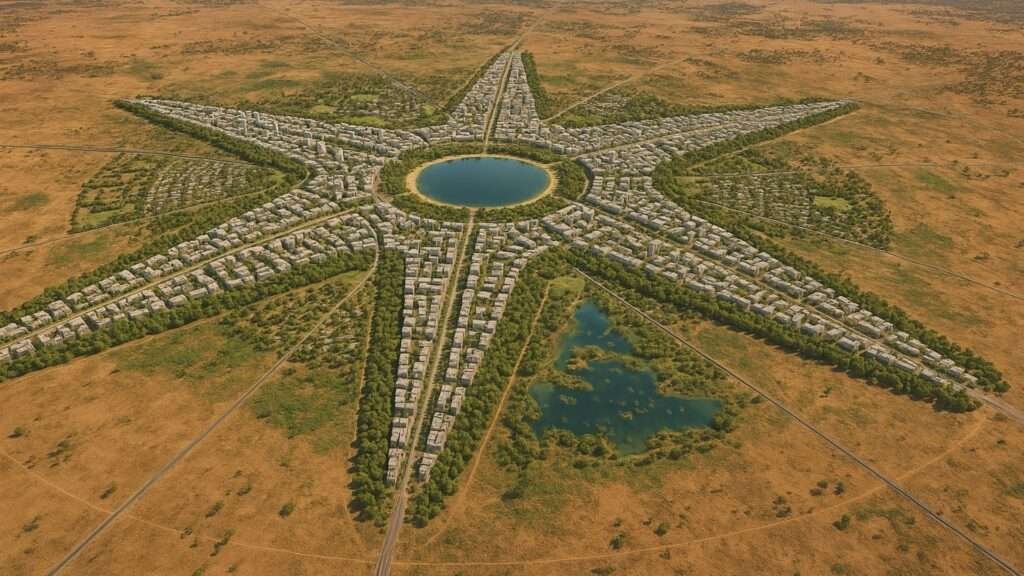
Starfish Cities: The Blueprint For The Future.
The Starfish City design and theory behind it is a bold reimagining of urban life and I hope Australia is where the first one will be created.
I believe this would be an amazing inland metropolis and they would be designed to support five million residents with dignity, resilience, and sustainability.
Built around a central saltwater lake and radiating through five symmetrically planned arms, this starfish-shaped city isn’t simply a design innovation, it’s a systems-level answer to climate instability, ecological degradation, homelessness, and infrastructure overload.
Unlike conventional cities, Starfish integrates circular economy principles, zero-discharge water infrastructure, climate-responsive architecture, and community-centered governance.
It turns plastic into fuel, sewage into power, waste into wealth, and transit into empowerment. Each arm operates as a self-sufficient community, connected by AI-optimized mobility, distributed renewable energy, smart logistics, and integrated social services.
Backed by strategic frameworks like SWOT and Porter’s Five Forces, I feel that the Starfish City Design isn’t just visionary, I believe they will be replicable, adaptive and primed for export to regions facing water scarcity, migration pressure, and post-carbon transition.
This article outlines the ten foundational systems of a Starfish City, followed by 11 cross-cutting implementation strategies to ensure operational readiness, governance integrity, and long-term civic success.
Table of Contents
1. Water Supply & Treatment
o Gravity-fed dams, zero-discharge desalination, reuse pipelines
2. Waste Management & Circular Economy
o CAT-HTR recycling, FastOx gasification, biogas recovery
3. Energy & Power Integration
o Solar rooftops, pumped-storage hydro, biogas hybrid plants
4. Manufacturing & Industrial Zones
o Modular housing, EV battery assembly, materials innovation
5. Transportation & Mobility
o Smart highways, 24/7 metro, micromobility, walkable corridors
6. Social Infrastructure & Emergency Services
o Hospitals, schools, recreation hubs, disaster command systems
7. Digital & Smart-City Systems
o IoT sensors, digital twin, 5G connectivity, ethical AI
8. Environmental Resilience & Biodiversity
o Green belts, wetlands, urban agriculture, climate buffers
9. Strategic Frameworks
o SWOT analysis, Porter’s Five Forces, differentiation strategy
10. Next Steps: From Vision to Implementation
o Pilots, governance, financing, community co-creation
11. Cross-Cutting Considerations
o Regulatory planning, asset operations, stakeholder engagement, R&D
The best thing about this article and concept is that it dares to do two things simultaneously and rarely successfully: dream big while remaining fiercely practical.
I firmly believe the Starfish City concept isn’t just a utopian sketch; it’s a living system built from measurable parts, saltwater lakes, bio-swales, housing modules, circular industry zones and decentralized governance.
The inspiration for this article came from this article on homelessness: Marketing-Leadership-Policy And Our Homelessness Crisis – Topload Brands
Section 1: Water Supply & Treatment.
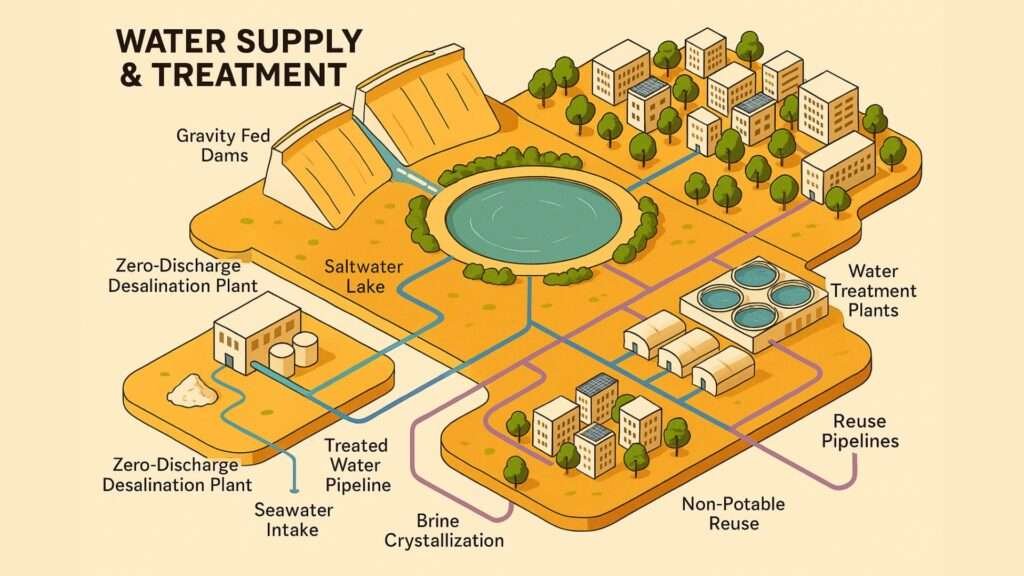
Laying the Foundation for Starfish City’s Resilience.
A city’s greatness tends to hinge on its capacity to sustain life, industry and progress, none of which exist without a secure, future-ready water system.
For an inland metropolis designed for five million people, water security is both a technical imperative and a civic promise.
This section breaks down how Starfish City’s water network blends proven infrastructure with cutting-edge circular solutions to capture, purify, reuse, and value every drop.
1.1 The Water Challenge for Inland Megacities.
Inland urban growth collides with aridity, variable rainfall, and the risk of aquifer depletion. Starfish City upends this by pairing perimeter dams with zero-discharge desalination and full reuse systems. The result is a model where scarcity becomes opportunity, and every liter fuels resilience rather than loss.
1.2 Drinking Water Dams: The First Line of Defense.
Location: One dam at the tip of each radial arm maximizes catchment and provides redundancy.
Capacity: Combined storage of 1,000 GL secures residential, commercial, and light-industrial demand.
Distribution: Gravity-fed trunk lines deliver water passively to homes, parks, and irrigation zones.
Operability: IoT-monitored spillways and modular outlets adapt in real time to floods or droughts.
Each reservoir doubles as a public amenity—lakeside promenades and lookout platforms invite stewardship and reinforce water’s role as a shared resource.
1.3 Zero-Discharge Desalination: Drought Insurance.
Process: Reverse osmosis → brine concentrators → crystallizers that extract every drop of freshwater.
Scale: 200 ML/day capacity boosts supplies when dams dip below safe levels.
Circular Benefits: Solidified salts feed local industries (chemical production, eco-concrete), turning waste into value.
Zero liquid discharge protects downstream ecosystems, recovers minerals as economic assets, and uses waste heat from nearby power plants to cut energy needs.
1.4 Integrated Water Distribution: Gravity and Smart Controls.
Gravity Flow: Positioned above the central basin, dams feed the city naturally—minimizing pumps.
Smart Metering: Digital meters in every building link to a central operations hub for leak detection and demand forecasting.
Zonal Redundancy: Independent networks on each arm isolate issues and maintain supply during maintenance or emergencies.
1.5 Advanced Treatment & Full Reuse.
Multi-Stage Filtration: Initial screening → wetland-based biofiltration → membrane and carbon polishing.
Disinfection: UV and ozone technologies eliminate pathogens without harmful byproducts.
Reuse Pipelines: Purple mains carry Class A+ recycled water for irrigation, cooling towers, industrial processes, and firefighting.
This dual-supply architecture slashes potable demand and embeds circularity into daily life.
1.6 Resilience & Community Stewardship.
Distributed Storage: Multiple reservoirs and buried tanks buffer extremes of flood and drought.
Automated Valving: Remote-controlled shutoff secures zones against contamination or cyber threats.
Mobile Filtration Units: Rapid-deploy mini-plants ensure continuity during major outages.
Digital Twin: A real-time virtual model simulates stresses—heatwaves, power loss, cyberattacks—so operators optimize before crises strike.
Water Culture: Gamified dashboards, neighborhood challenges, and school programs foster collective ownership and transparency.
1.7 Aligning with World-Class Benchmarks.
Inspired by Singapore’s NEWater and California’s drought-management programs, Starfish City weaves together proven tactics and novel innovations.
By integrating reservoirs, ZLD desalination, smart controls, and full-reuse pipelines, it proves that inland cities can surpass coastal peers in sustainability and resilience.
By capturing, purifying and valuing every drop again and again, the Starfish City Design establishes water security as its moral and operational backbone, setting a new global standard for urban life in a changing climate.
Section 2: Waste Management & Circular Economy.
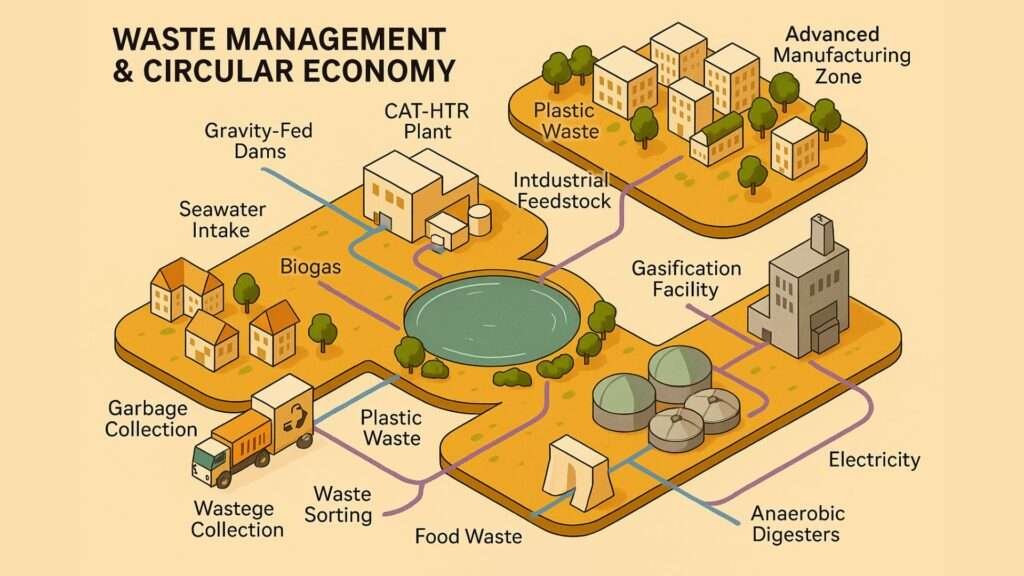
Let’s Turn Waste into Wealth.
In Starfish City, waste isn’t a problem to bury, it’s a resource to harness.
By embedding circularity into every sector, energy, manufacturing, agriculture, and public health, the city transforms its metabolic output into raw materials, fuels, and economic opportunities.
To serve five million residents with minimal ecological impact, Starfish City relies on four core technologies that convert diverse waste streams into high-value byproducts.
2.1 Four Pillars of the Waste Ecosystem.
Technology | Role | Output / Input |
CAT-HTR | Chemical recycling of mixed plastics | Hydrocarbon oils → plastics & fuels |
FastOx Gasification | Plasma-enhanced MSW conversion | 1 tonne waste → ~2 GJ syngas |
Waste-to-Energy (WTE) | High-efficiency incineration | 1 tonne MSW → ~600 kWh + district heat |
Anaerobic Digesters | Organic sludge & food waste breakdown | 1 tonne sludge → ~75 m³ biogas |
Each facility is co-located within its arm’s industrial zone, minimizing transport and feeding adjacent manufacturing, energy, and agricultural systems.
2.2 CAT-HTR: Closing the Plastics Loop.
Mix-and-match plastics evade municipal recycling, but Catalytic Hydrothermal Reactors solve this by:
1. Shredding plastics and mixing with supercritical water under pressure for ~20 minutes.
2. Breaking polymer chains into hydrocarbon oils and waxes.
3. Refining outputs on-site into diesel, petrochemical feedstock, or process heat.
Key benefits:
1. Handles films, wrappers, and contaminated containers.
2. Operates at sub-combustion temperatures—no additional pollutants.
3. Feeds clean oils directly to adjacent materials-innovation parks.
2.3 FastOx Gasification: Turning Trash into Syngas.
For residual MSW, FastOx uses plasma torches to vaporize waste into syngas (CO + H₂) without burning:
· Output: ~2 GJ syngas per tonne of waste.
· Byproduct: Vitrified slag for road base, tiles, and aggregates.
Environmental wins:
1. 90% landfill diversion.
2. Zero smoke or dioxin formation.
3. Syngas fuels combined-cycle generators on-site.
2.4 Waste-to-Energy: A Clean Incineration Model.
High-biomass or non-recyclable residues enter modular WTE units that:
1. Produce up to 600 kWh electricity and district heat per tonne of MSW.
2. Capture CO₂ for algae bioreactors or mineral carbonation.
3. Use dry sorbent injection to remove SOₓ and NOₓ.
4. Serve as “energy peakers” during winter demand spikes.
2.5 Anaerobic Digesters: Tapping the Organic Pulse.
Every flush and food scrap becomes fuel in large-scale digesters:
1. Inputs: Sewage sludge + household and market organics + aquaponics residue.
2. Outputs: Methane-rich biogas for turbines or pipeline-grade biomethane.
3. Digestate: Nutrient-rich solids for soil enrichment in urban agriculture.
Digesters pair with greenhouse complexes, using captured CO₂ and heat to boost productivity.
2.6 System-Wide Integration.
Energy Cascades: Syngas and biogas power gas turbines; exhaust heat feeds district heating and desalination.
Material Recovery: Slag and digestate become construction materials and soil amendments.
Circular Logistics: Piped oils and gases flow directly between waste plants and industrial users.
2.7 Culture, Policy & Civic Engagement.
Smart Bins: RFID-tagged sorting earns rebates or public-space credits.
Household Dashboards: Real-time waste metrics gamify reduction and reward high performers.
Repair Cafés: Neighborhood centers host workshops to extend product lifespans.
Regulatory Framework:
1. Mandatory Extended Producer Responsibility for packaging.
2. Building certifications tied to waste-sorting performance.
3. Ban on organic waste to landfill, mirroring EU best practices.
2.8 Performance Metrics & Economic Impact.
A transparent dashboard tracks key targets:
Metric | Target |
Waste to landfill rate | < 2 % |
Material recycling rate | > 70 % |
Organic diversion | 100 % |
Energy offset from waste streams | > 15 % of city demand |
Annual carbon offset | ~ 400,000 t CO₂ e |
Circular industries seed green-job growth, attract cleantech startups, and offer exportable modular solutions, turning waste management into an economic multiplier.
Section 2 Conclusion:
By treating waste as a continuous feedstock, Starfish City not only minimizes environmental harm but creates wealth, jobs and energy security.
This closed-loop strategy underpins the city’s resilience and positions it as a global leader in circular urban design.
3. Energy & Power Integration: Clean Energy Backbone.
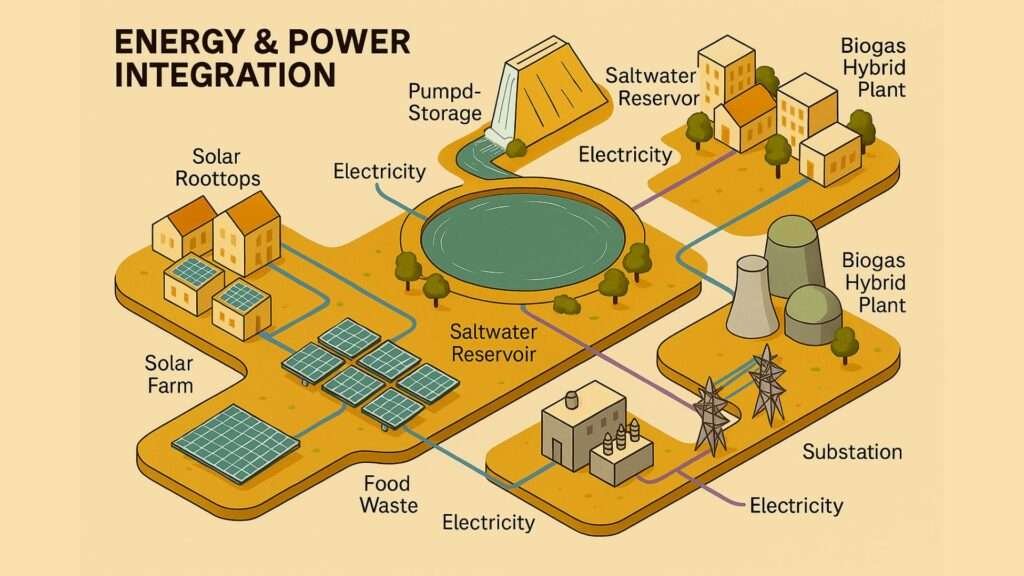
An urban grid for five million residents demands reliability, flexibility, and emissions-free power.
Starfish City layers renewables, storage, dispatchable generation and smart controls into a single, resilient network that ensures energy abundance in every season and scenario.
3.1 Distributed Renewable Generation
Every sun-, wind-, and water-facing surface becomes a generator:
· Rooftop & BIPV • 100% of building roofs and sun-lit façades sport PV panels or integrated photovoltaics (BIPV). • Simulations show rooftop alone can meet 50–60% of annual demand; façades push that above 70%.
· Perimeter Solar Farms • Ground-mounted arrays on the outer arms provide a dependable baseline. • Modular trackers optimize yield from dawn to dusk.
· Micro-Wind on Water Infrastructure • Compact turbines on dam walls and lakeshores harvest prevailing breezes. • Some turbines double as mechanical pumps, feeding pumped-storage systems.
3.2 Grid-Scale Storage & Flexibility
Long-duration reserves stabilize the ebb and flow of renewables:
· Underground Battery Caverns • Compressed-air and flow-battery installations in salt caverns store multiple gigawatt-hours. • Footprint is minimal; discharge duration spans days, not hours.
· Pumped-Storage Hydropower • Dual-elevation reservoirs on lake margins act as gravity batteries. • Target capacity: 10 GWh per full cycle, backing up peak loads in summer heat and winter chill.
3.3 Hybrid Gas & Biogas Plants
Dispatchable plants secure baseload and rapid response:
· Single-Cycle & Combined-Cycle Units • Each city hosts one of each, fueled by local methane and upgraded biogas. • Quick ramp-up and black-start capabilities ensure grid stability.
· Thermal Integration • Waste heat drives district heating loops, desalination crystallizers, and industrial processes. • Co-location with wastewater digesters maximizes biogas capture.
3.4 Smart Grid & Microgrid Controls
Intelligent networks amplify resilience and efficiency:
· Real-Time Monitoring • Sensors across generation, storage, and load feed a central energy-operations center. • Automated switching balances supply sources in milliseconds.
· Arm-Level Microgrids • Each radial sector can “island” itself, supporting critical services if other zones go offline. • Local black-start reserves guarantee emergency power.
· Demand Management • Smart meters and dynamic tariffs smooth peaks, incentivizing off-peak usage. • Virtual Power Plant (VPP) program pools rooftop PV and home batteries for grid services.
3.5 Circular Thermal Integration
Every joule of excess heat finds purpose:
· Waste-to-Energy Synergy • Heat from incineration and gasification plants feeds aquaponic greenhouses and district boilers. • Combined heat-and-power (CHP) loops boost overall efficiency above 80%.
· Desalination & Materials Processing • Power-plant waste heat powers crystallizers in zero-discharge desal, cutting energy demand by 20%. • Industrial facilities tap thermal streams for process heating.
3.6 Net-Zero Impact, Equity & Resilience
· Emissions Elimination • Layered renewables, storage, and circular fuels set a trajectory to net-zero by design—no offsets needed.
· Social Equity • Distributed generation slashes utility bills citywide and democratizes access. • VPP credits and community-owned solar funds share benefits with all residents.
· Climate Resilience • Redundant supply vectors guard against extreme weather, grid failures, or supply shocks. • Modular design allows phased expansion and tech upgrades.
3.7 Future-Proofing & Innovation Pilots
· Next-Gen Storage R&D • Trials of metal-air and organic flow batteries target 50 GWh scale.
· Green Hydrogen Hub • Excess renewables drive electrolysis, creating hydrogen for hard-to-electrify sectors and export.
· Resident Participation • Energy-sharing apps empower households to trade surplus power and earn credits.
By weaving distributed renewables, vast storage, dispatchable generation and intelligent controls into one seamless grid.
Starfish City proves that energy abundance and climate neutrality are not just goals, they’re the very backbone of a thriving, future-ready metropolis.
Section 4: Manufacturing & Industrial Zones.
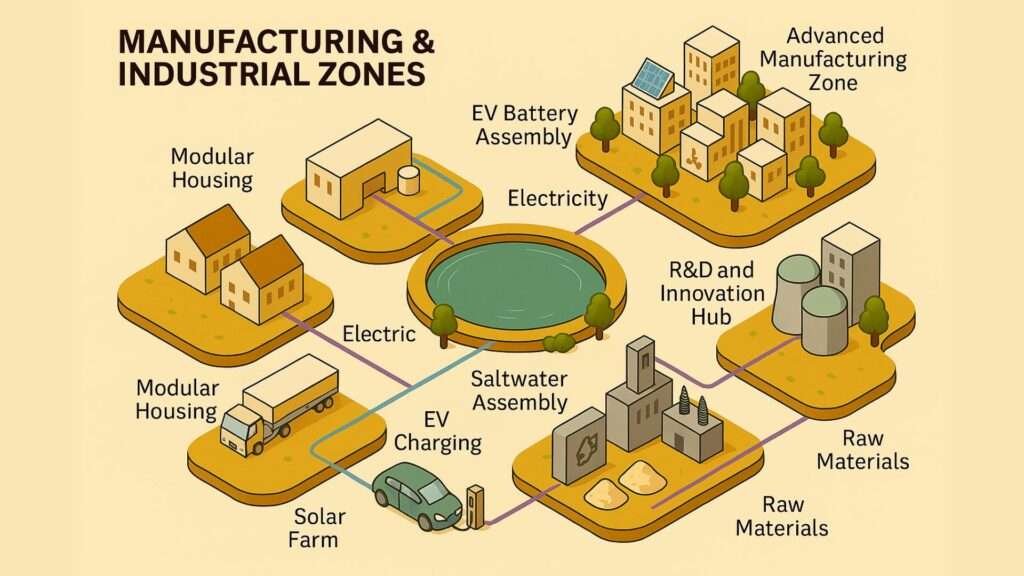
In a Starfish City, manufacturing won’t be an afterthought, it’ll be the engine room of a circular economy. Strategically placed in buffer belts along each arm, industrial zones absorb waste streams, regenerate materials, and drive local employment while seamlessly integrating with transport, energy, water, and waste systems.
4.1 Spatial Blueprint: Industrial Buffer Belt Strategy
Why the Arms?
· Isolated enough to contain noise and emissions
· Connected directly to arterial roads and rail spurs
· Adjacent to desalination, waste-processing, and energy hubs
· Topographically suited for large lots and clean-tech test beds
Design Principles:
· Zonally Autonomous Modules: Independent power, water recycling, and waste handling
· Modular Lots: 2,000–20,000 m² “plug-and-play” plots with shared logistics
· Green Buffers & Bio-swales: Native plantings for stormwater capture and screening
· Vertical Typologies: Multi-storey factories near urban cores to save land
4.2 Priority Sectors
1. Modular Housing & Assembly
o Mass-timber panels, 3D-printed concrete, net-zero pods
o Feedstock: Gasifier slag and certified fast-growth timber
o Cuts build time by 80%, labor by 60%, emissions by 50%
2. Battery & EV Production
o LFP and sodium-ion cell gigafactories
o Microfactories for two-wheelers, microcars, transit shuttles
3. Food Processing & Circular Agribusiness
o Aquaponics hubs transforming fish and vegetable outputs
o Biorefineries converting organics into proteins, oils, and CO₂
4. Advanced Recycled Materials
o 100% recycled plastics from CAT-HTR oil feedstock
o Green concrete with fly ash, vitrified slag, and CO₂ curing
5. Clean Industrial Chemistry
o Green hydrogen, graphene, bio-polymers from renewable surpluses
o Carbon black alternatives from agricultural and plastic waste
4.3 Smart Integration with Core Systems
Energy
· Factories tap district energy loops with waste-heat reuse
· Onsite solar and micro-wind power high-demand processes
Water
· Purple-pipe water (ZLD-treated/desalinated) for cooling and cleaning
· Closed-loop cooling towers preserve resources
Waste
· Direct feeds from collection systems into recyclers and digesters
· Slag and digestate upcycled in construction and urban farms
4.4 Logistics, Automation & Export
· Connectivity: Ring-road highways, dedicated underground freight tunnels, rail spurs
· Last-Mile: Electric vans, autonomous drones for micro-distribution
· Smart Hubs: Bonded logistics zones with blockchain tracking for transparency
4.5 Employment, Training & Inclusive Growth
· Workforce Goals: 1 job per 4 residents in green manufacturing and support services
· Standards: High safety, gender inclusion, living wages
· Education: Technical colleges on each belt offering diplomas in robotics, materials science, and mechatronics
· Community Access: Maker labs and viewing galleries demystify industry for residents
4.6 Climate Alignment & Carbon Performance
Metric | Target |
Circular Materials Usage | > 75% of industrial inputs |
Industrial Water Recycling | > 90% |
Scope 1 & 2 Emissions | Net-zero by 2040 |
On-site Renewable Energy | ≥ 60% of total consumption |
Product Packaging Recyclability | 100% |
Carbon accounting is automated and displayed on the city dashboard for full transparency.
4.7 Conclusion: Industry Re-imagined
Starfish City’s industrial belts are more than production zones, they are circular engines turning waste into wealth, creating dignified employment and supplying the very materials needed to build and maintain a resilient, net-zero metropolis.
Every product exported, whether a modular home, a clean battery, or climate-positive concrete carries Starfish City’s blueprint for regenerative urbanization.
Section 5: Transportation & Mobility
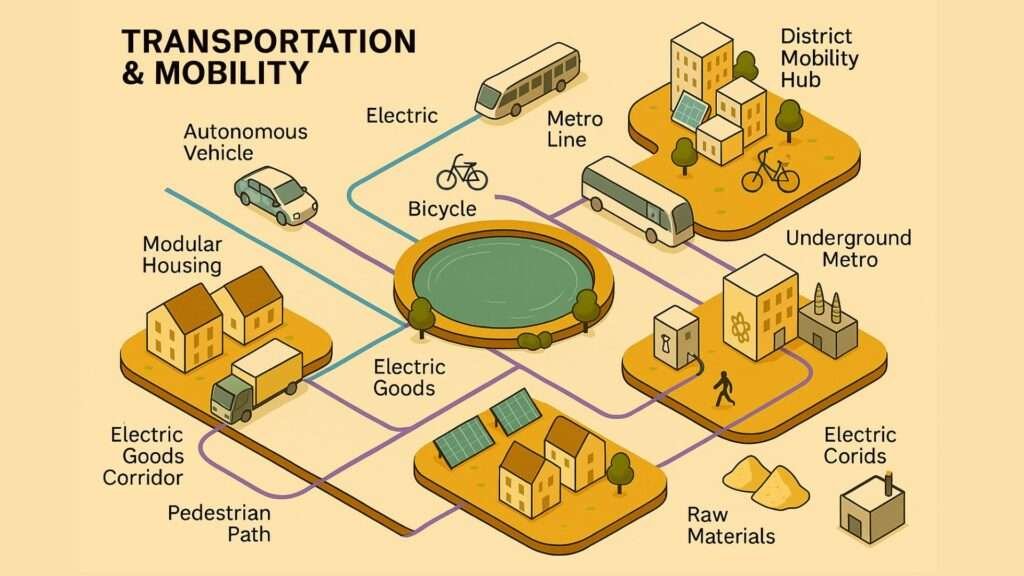
A city’s success depends on how effortlessly people, goods, and information flow. In Starfish City, mobility is not an afterthought but the connective tissue woven into its radial design.
With five million residents across five arms centered on a saltwater lake, our system combines high-capacity rail, 24/7 electric buses, inductive-charging highways, and human-scaled active transport to deliver seamless, zero-emissions mobility.
5.1 Multi-Modal Mobility System
Starfish City’s mobility network is engineered for synchrony across speed, distance, and purpose:
· Metro Rail: Five radial rapid-transit lines linking each arm to the central hub.
· Electric Bus Rapid Transit (eBRT): Dedicated lanes on every arm, operating 24/7.
· Active Transit: Pedestrian boulevards and protected cycle superhighways.
· Last-Mile Shuttles & Micromobility Fleet: Autonomous pods, e-bikes, and scooters.
· Smart Highways: EV/HOV-only lanes with embedded inductive charging.
5.2 Smart Road Network
Each arm is served by an 8-lane arterial (4 each direction) configured for efficiency and safety:
· 2 EV/HOV Lanes: Inductive coils recharge vehicles in motion.
· 2 Freight/Service Lanes: Dedicated for electric and autonomous logistics.
· Adaptive Pavement Sensors: Real-time data on traffic, temperature, and air quality.
· Dynamic Tolling: Congestion pricing that shifts demand to off-peak hours.
5.3 Metro Rail System
Our rail network is the city’s high-capacity spine:
· Five Radial Lines: Fast, reliable service from arm termini to the lakefront hub.
· Central Isthmus Station: Subterranean interchange beneath the lakefront plaza.
· 5-Minute Headways: Predictive AI optimizes train dispatch and platform flow.
· Green Stations: Solar canopies, green roofs, regenerative braking, and local art integration.
5.4 Electric Bus Transit
Coverage-First Planning ensures every resident is within 400 m of service:
· Arm-Level Feeder Networks: Connect homes, schools, clinics, and recreation.
· Demand-Responsive Routing: AI reallocates buses in real time to match passenger loads.
· Long-Range Fleet: Articulated buses with 400 km battery range, charged by solar depots.
· Night-Shift Access: Guaranteed service for 24/7 economy workers and vulnerable populations.
5.5 Last-Mile Mobility
Closing the gap from transit node to front door:
· Autonomous Neighborhood Shuttles: Bookable via app, operating on micro-loops.
· Bikeshare & E-Scooter Hubs: Solar-powered docking at all major stations.
· Priority Micromobility Paths: Signal-separated crossings and dedicated lanes.
5.6 Walkability & Active Movement
Human-scaled design for healthy, low-carbon travel:
· Green Corridors: 15 km+ linear parks along each arm, with bioswales and native plantings.
· Covered Cycleways: Weather-protected lanes with solar-lit rest pods and hydration points.
· Universal Accessibility: Tactile paving, audio cues, gentle gradients, and clear signage.
5.7 Intelligent Mobility Management
A city-wide digital twin drives continuous improvement:
· Connected Vehicles: Live vehicle-to-infrastructure communication for optimal routing.
· Predictive Transit Forecasting: AI anticipates surges and adjusts capacity.
· User-Centric Apps: Real-time trip planning, carbon-impact tracking, and multimodal options.
5.8 Urban Logistics & Freight Distribution
Efficient movement of goods sustains the circular economy:
· Electric Freight Lanes: Designated corridors for zero-emissions delivery trucks.
· Microhubs: Local consolidation points at arm junctions and industrial belts.
· Underground Freight Tunnels: Long-term goal to separate cargo from passenger streets.
5.9 Equity, Accessibility & Affordability
Mobility as a universal right:
· Fare Subsidies: Free or discounted travel for students, seniors, and low-income residents.
· Barrier-Free Design: All modes, stations, and vehicles are fully accessible.
· Community Co-Design: Annual digital consultations and VR town halls to shape service.
5.10 Performance Metrics & Targets
Metric | Target |
Public Transport Mode Share | ≥ 60 % of all trips |
Zero-Emissions Vehicle Share | 100 % by 2035 |
Bicycle & Walking Share (Intra-Arm Trips) | ≥ 40 % |
Cross-Arm Trip Time | ≤ 20 minutes |
Transport Emissions per Capita | < 500 kg CO₂/year |
Transit Accessibility | 100 % of residents ≤ 400 m from a stop |
Conclusion: A City That Moves Seamlessly.
Starfish City’s mobility network is a layered tapestry—dynamic, equitable and zero-emissions.
It empowers every resident and supports every sector, binding the city’s arms into one resilient, thriving organism.
In this model, movement becomes more than transport, it’s the lifeblood of a sustainable urban future.
Section 6: Social Infrastructure & Emergency Services.
A city of five million thrives when its people feel supported, safe, and connected.
In each Starfish City, social infrastructure and emergency services would be woven into the radial layout, creating vibrant neighborhood hubs that link seamlessly to citywide systems.
From healthcare and education to recreation, safety, and digital integration, this network fosters equity, well-being, and collective pride.
6.1 Arm Sector Social Hubs: Localized, Yet Connected
Each arm hosts a balanced suite of facilities scaled to its population, ensuring every resident has essential services within easy reach.
Sector | Primary Facilities | Services & Capacity |
Residential | Community centers, primary schools, kindergartens | Early learning, family programs, neighbourhood events |
Healthcare | 1× 400-bed hospital + 3× clinics per arm | Emergency, surgical, outpatient, preventive care |
Emergency | Fire stations, police precincts, ambulance HQs, command centers | Rapid response, disaster coordination |
Education | Technical college + university campus per arm | Vocational training, degrees, research |
Recreation | Parks, sports complexes, theaters, galleries | Playgrounds, team sports, arts and cultural programs |
6.2 Healthcare Infrastructure: Accessible and Integrated
Starfish City delivers seamless care through tiered medical services:
· Arm-level hospitals with modular wards ready to expand as populations grow
· Satellite clinics for primary care, mental health, chronic disease management, and telemedicine
· IoT-enabled patient monitoring linked to a central health database
· Academic partnerships for on-site research, innovation, and workforce training
6.3 Education & Skills Development: Shaping Tomorrow’s Workforce
Human capital drives innovation. Starfish City’s education network includes:
· Technical colleges offering diplomas in clean tech, urban agriculture, renewable energy, and digital skills
· University campuses fostering research and startups in circular economy and smart infrastructure
· Community workshops on digital literacy, civic engagement, and sustainability
· Transit-integrated campuses for universal access via metro, bus, bike, or foot
6.4 Emergency Services: Preparedness and Rapid Response
Safety relies on proactive readiness and swift action:
· Fire and rescue stations distributed to guarantee response times under six minutes
· Community-policing precincts augmented by ethical AI surveillance and analytics
· Ambulance depots co-located with hospitals for seamless patient transfer
· Central disaster command center integrating weather, seismic, and hazard data
· Regular drills, public outreach, and resilience training for all neighborhoods
6.5 Recreation & Cultural Spaces: Nurturing Social Cohesion
Public spaces are the heart of community life:
· Interconnected parks and green corridors as outdoor “living rooms”
· Multi-sport complexes for both elite events and grassroots leagues
· Theaters, galleries, and maker spaces celebrating local heritage and creativity
· Accessible design with ramps, sensory gardens, and adaptive equipment for all abilities
6.6 Digital & Environmental Integration
Technology and nature work in tandem to enhance service delivery:
· IoT sensors monitor air quality, noise, and crowding in real time
· Digital twin models simulate emergency scenarios and optimize resource allocation
· 5G connectivity underpins telehealth, virtual classrooms, and community apps
· Smart alerts deliver personalized emergency and event notifications
6.7 Equity & Inclusion: Ensuring Universal Access
Design principles guarantee no one is left behind:
· Universal design standards across all facilities, ensuring age- and disability-friendly access
· Distributed hubs prevent service “deserts” and reduce travel burdens
· Community centers host support programs for mental health, financial literacy, and domestic violence prevention
· Governance structures include resident advisory councils and virtual town halls
6.8 Performance Metrics & Targets
Transparent metrics drive continuous improvement:
Metric | Target |
Hospital beds per resident | 1 bed per 1,250 residents |
Primary school enrollment | 100 % of eligible children |
Emergency response time | < 6 minutes across all arms |
Parkland per capita | ≥ 12 sqm per person |
Transit-to-facility access | ≥ 95 % of residents in 10 minutes |
Community satisfaction index | > 85 % positive feedback |
Section 6 Conclusion:
By embedding social services, emergency readiness and cultural amenities into its very geometry and layering digital and environmental intelligence, each Starfish City would create not just neighborhoods, but nurturing communities.
Here, it is hoped that every resident has the support, opportunity, and connectivity needed to thrive.
Section 7: Digital & Smart-City Systems.
Starfish City’s physical infrastructure is underpinned by a dynamic digital layer—an intelligent network of sensors, analytics, and citizen interfaces that transforms the metropolis into a responsive, resilient organism. From real-time surveillance and IoT monitoring to digital twins and ubiquitous connectivity, this “nervous system” optimizes operations, enhances safety, and puts residents at the center of urban management.
7.1 City-Wide AI-Enabled Surveillance & Security
Balancing public safety with privacy, Starfish City uses:
· Adaptive Monitoring: Edge-AI cameras detect crowding, hazards, or unusual behavior in real time.
· Privacy Zones: Virtual masking over residential blocks ensures no video feed is stored or analyzed.
· Integrated Alerts: Security incidents trigger automated notifications to emergency services and affected residents.
· Secure Architecture: Encrypted data streams and segmented networks guard against cyber threats.
An independent oversight committee of residents, legal experts, and civil-rights advocates governs policy, ensuring transparency and trust.
7.2 IoT Sensor Networks: The City’s Sensory Organs
Thousands of wireless sensors create fine-grained visibility into:
· Traffic flow and parking availability
· Air and water quality metrics
· Waste-bin fill levels for optimized routing
· Energy consumption and grid health
A robust mesh network (IEEE 802.15.4g) and AES-256 encryption guarantee interoperable, scalable, and secure data collection.
7.3 Digital Twin: Virtual Replica for Dynamic Management
The city’s real-time digital twin enables:
· Urban Planning Simulations: Test new developments, zoning changes, or infrastructure upgrades before ground-breaking.
· Disaster Drills: Model floods, fires, power outages, and cyberattacks to optimize emergency response.
· Predictive Maintenance: Forecast wear in critical assets—pumps, transformers, transit lines—to schedule cost-effective repairs.
· Energy Balancing: Virtually adjust power flows across distributed generation and storage for maximum efficiency.
Stakeholders access tailored dashboards and mobile portals for decision-making, operations, and public transparency.
7.4 Connectivity Infrastructure: The Digital Backbone
A multi-layered network ensures zero-lag, city-wide connectivity:
· 5G Coverage: Ultra-low latency and massive device density for IoT, AR/VR, and autonomous systems.
· Municipal Wi-Fi: Free access in parks, transit hubs, and community centers to close the digital divide.
· Fiber-Optic Backbone: High-capacity links for business districts, data centers, and critical facilities.
· Smart Street Furniture: Poles equipped with environmental sensors, charging stations, and public displays.
Open-source protocols and modular designs future-proof the network against evolving technologies.
7.5 Integrated Emergency Alerts & Public Communications
A redundant, multichannel alert system delivers:
· Push notifications to smartphones and wearables
· Voice PA and digital signage updates in public spaces
· Real-time evacuation routes via transit and digital-twin apps
· Zone-specific warnings for targeted hazards
Multiple communication pathways—cellular, Wi-Fi, and mesh radio—guarantee uninterrupted service during crises.
7.6 Citizen Engagement Platforms: Co-Creating the Urban Experience
Engaging residents as co-designers fosters ownership and continuous improvement:
· VR Town Halls: Interactive 3D sessions where citizens explore proposals and provide feedback.
· Crowdsourced Reporting Apps: Simple interfaces for reporting issues, suggesting improvements, or joining sustainability challenges.
· Open Data Dashboards: Public displays of air quality, transit performance, and infrastructure health.
This transparency builds trust and accelerates community-driven innovation.
7.7 Data Privacy, Security & Ethical AI
Strong governance ensures responsible data use:
· Minimal Data Collection: Only essential personal data is gathered, anonymized whenever possible.
· Independent Audits: Regular reviews of AI algorithms and data-use policies for fairness and bias mitigation.
· Cybersecurity Operations Center: Continuous monitoring, threat hunting, and rapid incident response.
· Resident Controls: Clear consent flows and user portals to view, correct, or delete personal information.
7.8 Economic & Environmental Benefits
Smart-city technologies deliver measurable gains:
· Operational Efficiency: AI-driven analytics cut energy waste, water loss, and optimize waste-collection routes.
· Emissions Reduction: Adaptive traffic controls and demand-response energy management smooth peaks and minimize idling.
· Cost Savings: Predictive maintenance lowers upkeep costs and extends asset lifespans.
· Innovation Ecosystem: Open data spurs startups, university research, and public-private partnerships in smart-city solutions.
Section 7 Conclusion:
By embedding intelligence across surveillance, sensor networks, digital twins, and citizen platforms, each Starfish City could surely become more than a built environment, it will hopefully evolve into a living system.
The digital nervous system ensures safety, efficiency, and equity, making the city adaptive to today’s challenges and tomorrow’s unknowns.
Section 8: Environmental Resilience & Biodiversity.
Building inland for five million people demands more than sustainability—it requires regenerative urbanism.
Starfish City’s landscape is woven into its infrastructure and governance, turning every street, park, and building into a habitat, buffer, or climate regulator.
This living framework restores ecosystems, mitigates extremes, and reconnects citizens with nature.
8.1 Green Belts: Ecological Arteries
Each arm is flanked by continuous green belts—ribbons of native habitat that:
· Serve as wildlife corridors, linking fragmented landscapes
· Buffer urban zones without hard infrastructure walls
· Sequester carbon through layered plantings (grasses → shrubs → forest edges)
· Reflect local identity through indigenous species and cultural plantings
Connectivity Features:
· Minimum width of 300–500 m to sustain viable populations
· “Green Bridges” and eco-tunnels at road crossings
· Integrated pedestrian and cycle trails for immersive access
8.2 Central Lake & Saltwater Buffer: Climate Engine
The heart of Starfish City is a vast saltwater lake that:
· Moderates diurnal temperature swings via thermal mass
· Provides evaporative cooling to adjacent neighborhoods
· Captures and stores stormwater runoff for reuse
· Integrates with zero-discharge desalination for closed-loop water exchange
Surrounding Wetlands:
· Engineered and natural marshes filter pollutants
· Habitat for migratory birds, amphibians, and pollinators
· Flood attenuation through temporary water storage
· Carbon capture in reed and algae biomass
8.3 Microclimate Control & Urban Cooling
To counter urban heat islands, Starfish City deploys:
· Tree-Lined Streets: 50% canopy cover target on all arterials
· High-Albedo Materials: Light-colored, permeable pavers that reflect solar radiation
· Green Roofs & Walls: Vegetation layers on buildings for shade and insulation
· Solar-Powered Mist Towers: Park-mounted units that spray lake-sourced mist, dropping local temps by up to 6 °C
8.4 Stormwater Harvesting & Reuse
Every raindrop is a resource rather than a runoff:
· Bio-Retention Swales: Linear vegetated channels along green belts and cycleways
· Permeable Surfaces: Roads and sidewalks that allow onsite infiltration
· Subterranean Cisterns: Store excess for drought-proofing landscapes
· Dual-Loop Distribution: Non-potable water for irrigation, toilet flushing, and cooling
Performance Targets:
· ≥ 80 % of annual stormwater retained onsite
· ≥ 60 km of bio-swale corridors
· Outdoor potable use < 25 L/person/day
8.5 Urban Agriculture & Biodiversity Integration
Food systems double as ecological infrastructure:
· Community Gardens & Food Forests: Public plots seeded with pollinator-friendly plants
· Rooftop Farms: Lightweight soil beds producing vegetables and flowers
· Industrial Aquaponics: Fish and plants grown symbiotically using waste CO₂ and heat
· Edible Plazas: Planted with fruit, nuts, and medicinal herbs
8.6 Climate Risk Adaptation & Preparedness
Landscape design is stress-tested against century-scale scenarios:
· Flood-Resilient Parks: Terraced swales and sponge-garden landforms
· Wildfire Buffers: Irrigated plant zones to slow fire spread at urban edges
· Heatwave Refuges: Shaded cooling zones and nighttime transit for vulnerable groups
· Public Dashboard: Real-time climate risk indicators and planned interventions
8.7 Citizen Stewardship & Education
Long-term resilience depends on community engagement:
· School Programs: Ecological literacy embedded in K–12 curricula
· “Adopt-a-Swale” & “Tree Guardian” Initiatives: Neighborhood care of green assets
· AR Biodiversity Trails: Augmented reality guides for species spotting
· Citizen Science Apps: Data collection on wildlife, water levels, and plant health
8.8 Performance Metrics & Environmental Indicators
Indicator | Target |
Street Canopy Coverage | ≥ 50 % of public roads |
Native Biodiversity Index | Positive year-on-year gains |
Stormwater Retention | ≥ 80 % of annual volume |
Wetland Area Net Gain | + 300 % over pre-development |
Annual GHG Offset from Ecosystems | ≥ 250,000 t CO₂-e |
Fire & Heat Event Readiness | 100 % preparedness in all arms |
Section 8 Conclusion:
Environmental resilience and biodiversity are integral to Starfish City’s DNA.
By embedding living systems into its geometry, the city regenerates landscapes, buffers climate shocks and cultivates an urban culture of stewardship offering a blueprint for ecologically integrated inland megacities.
Section 9: Aligning with SWOT & Porter’s Five Forces.
The Starfish City Template for engineering and social innovations must also hold up under economic, political, and technological pressures.
Applying SWOT and Porter’s Five Forces reveals how the model secures competitive advantage, manages vulnerabilities, and positions itself as an exportable blueprint for future urban developments.
9.1 SWOT Analysis: Foundations of the Starfish Model
|
Strengths |
Weaknesses |
|
|
Closed-loop water, energy, waste, and food systems |
High upfront capital and technology integration cost |
|
|
Resilience by design (redundancy, storage, twins) |
Complex coordination and skilled workforce required |
|
|
24/7 multimodal transit reduces car dependency |
Inland location may deter coastal migrants or tourists |
|
|
Integrated circular-economy infrastructure |
Risk of over-engineering impacting affordability |
|
|
Walkable arms with strong local identity |
||
|
Opportunities |
Threats |
|
|
Exportable drought-proof city blueprint |
Rapid tech obsolescence if systems aren’t adaptive |
|
|
Hub for green manufacturing and bio-innovation |
Cybersecurity risks in digital systems |
|
|
Digital-twin services as a consulting offering |
Political complexity in public-private governance |
|
|
Modular disaster-resilient housing exports |
Climate extremes exceeding design assumptions |
|
9.2 Porter’s Five Forces: Urban Development Competitive Landscape
1. Threat of New Entrants (Low): High capital and regulatory barriers protect Starfish City’s first-mover advantage.
2. Supplier Power (Moderate-High): Niche providers of CAT-HTR, gasifiers, and digital twins can drive up costs; in-house R&D and open-source alternatives mitigate this.
3. Buyer Power (High): Government consortia as primary funders command significant bargaining leverage during planning and procurement.
4. Threat of Substitutes (Moderate): Traditional urban sprawl and edge-city models are cheaper initially but lack Starfish’s resilience and integration.
5. Rivalry Among Competitors (Moderate-Increasing): Emerging megacity concepts and tech campuses vie for investment; Starfish differentiates on true circularity and regional fit.
9.3 Strategic Differentiators
|
Differentiator |
Description |
|
Regenerative Infrastructure |
Systems that repair and renew water, waste, and ecology |
|
Resilience-by-Design |
Modular, distributed services with real-time digital oversight |
|
Civic-Integrated Technology |
Privacy-preserving AI and citizen co-ownership of data |
|
Global Adaptability, Local Roots |
Blueprint adjustable for diverse climates, cultures, and scales |
9.4 Roadmap to Strategic Success
1. Modular Replication Package turnkey “Starfish Arm” variants for climate-stressed regions, refugee camps, and post-disaster rebuilds.
2. Public–Private Partnerships Leverage green bonds, climate funds, and service-provider consortia to balance risk and local accountability.
3. Future-Readiness Index Develop an independent metric tracking climate resilience, system capacity, and continuity—use it to attract investors.
4. Networked Starfish Cities Establish a global alliance sharing open-source plans, data, and lessons across pilot deployments.
The Starfish City concepts strategic strength lies not in any single innovation, but in the orchestration of resilience, livability, inclusiveness and sustainability.
By reframing urban competition around systems thinking, this model reshapes what a city can be and what it can achieve.
Section 10: Next Steps: From Vision to Implementation.
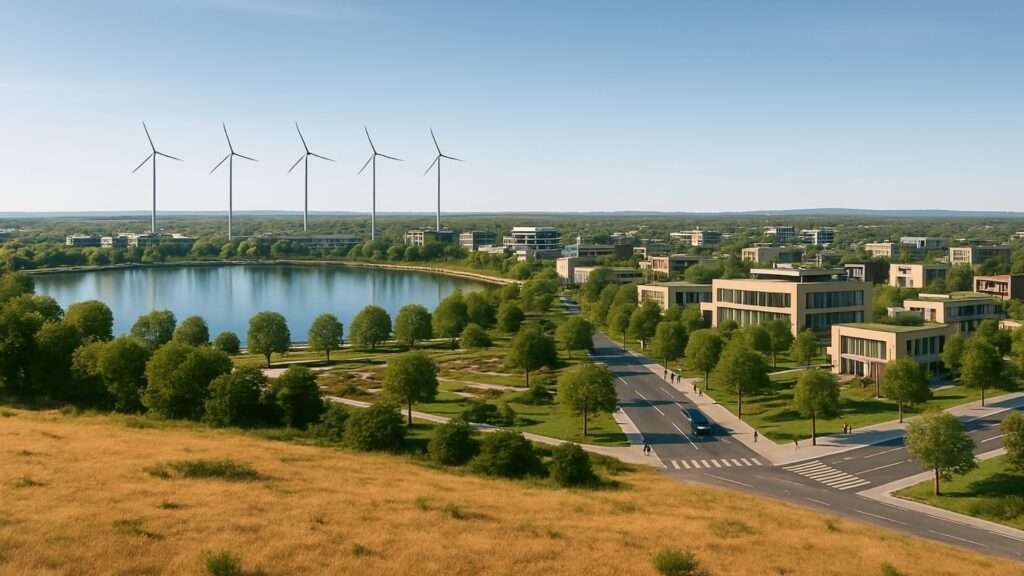
The hope for the Starfish City designs is more than a masterplan, it’s a blueprint for regenerative, climate-resilient urban living.
After outlining its infrastructure, social systems, and strategic positioning, we now chart the clear pathways that will turn vision into reality.
This section details phased pilots, planning refinements, governance architectures, community engagement tools, financing strategies, and scaling models needed to build the world’s first Starfish City.
10.1 Feasibility & Technology Trials
Before full-scale rollout, targeted pilots validate core systems and de-risk investments. These 12–24-month trials form living laboratories in collaboration with universities and industry partners.
System | Pilot Focus | Objective |
CAT-HTR Module | 10 t/day recycling unit | Verify plastic-to-oil yield and feedstock quality |
Zero-Discharge Desalination | 1 ML/day mini-plant | Test brine crystallization efficiency and salt purity |
Smart Mobility Hub | eBRT node + micromobility fleet | Measure modal split, grid impact, and passenger behavior |
District Digital Twin | Single-arm microgrid model | Validate AI-driven load balancing, predictive maintenance |
No major arm is constructed until its layers—water, waste, energy, mobility, digital—are proven at scale.
10.2 Masterplan Refinement & Micro-Zoning
A 5 million-person city demands iterative planning that balances diversity, culture, and function.
· Micro-Zones by Use: Startup incubators, artist quarters, eldercare clusters, youth hubs, advanced-R&D precincts, cultural districts.
· Civic Modules: Decentralized libraries, co-working spaces, community courts, NGO incubators embedded in neighborhoods.
· Cultural Ecology: Place-naming, public art, and planting palettes that honor Indigenous heritage and local histories.
Each arm evolves as a living ecosystem of housing, enterprise, learning, and stewardship.
10.3 Governance Model: Orchestrating Complexity
Starfish City thrives under a fit-for-purpose operating system—a hybrid public–private Special Purpose Vehicle (SPV).
· Structure: Not-for-profit SPV governed by city agencies, utilities, tech partners, Indigenous elders, and community representatives.
· Mandate: Coordinate water, energy, waste, transport, social services, and digital systems under unified KPIs.
· Transparency: Publish open data dashboards and annual independent audits; include resident councils in budget and design reviews.
· Agility: SPV iterates policy and infrastructure based on real-time sensor data and citizen feedback.
The SPV also licenses the Starfish methodology globally, offering consulting and turnkey solutions.
10.4 Community Engagement & Social License
Genuine co-creation builds trust and ownership. Starfish City employs a four-tier engagement strategy:
1. VR Town Halls Residents explore life-sized virtual neighborhoods and submit live feedback.
2. Gamified Planning Simulations Interactive budgeting and zoning games let citizens test trade-offs.
3. Co-Design Workshops AR-enabled sessions and tactical urbanism events shape parks, plazas, and public art.
4. Digital-Twin Audits Public portals display maintenance schedules, service benchmarks, and environmental data.
This transforms residents from observers into active builders of their city.
10.5 Financing Starfish City
A blended capital stack aligns with our values of resilience, circularity, and equity:
Mechanism | Purpose |
Green Bonds | Low-cost, climate-aligned funding for core infrastructure |
Impact Investment Funds | Capital for schools, hospitals, startups, affordability |
Federal Infrastructure Grants | Subsidize water, energy, and transport assets |
Public–Private Partnerships | Co-develop transit, data centers, desal plants |
Land-Value Capture | Recoup public investment through rising land values |
This multi-layered strategy ensures agility and long-term self-sufficiency.
10.6 Global Scaling & Long-Term Vision
Starfish City is a fractal template—adaptable to diverse climates and societies:
· Starfish Toolkit: Open database of modular designs (housing pods, desal units, transit algorithms).
· Learning Alliance: Network of pilot cities sharing data, lessons, and regional adaptations.
· Regenerative Jobs Program: Use local manufacturing legacies to seed green economies in regions facing energy transitions.
As the first operational Starfish City, this initiative will catalyze a global movement for equitable, regenerative urbanism.
Like its biological namesake, Starfish City embodies resilience and regeneration.
In the face of climate upheaval and social fragmentation, we can regrow our cities on systems of hope, shared purpose, and adaptive intelligence.
This is not just a plan, it’s a proposition for a better future.
Section 11: Cross-Cutting Considerations.
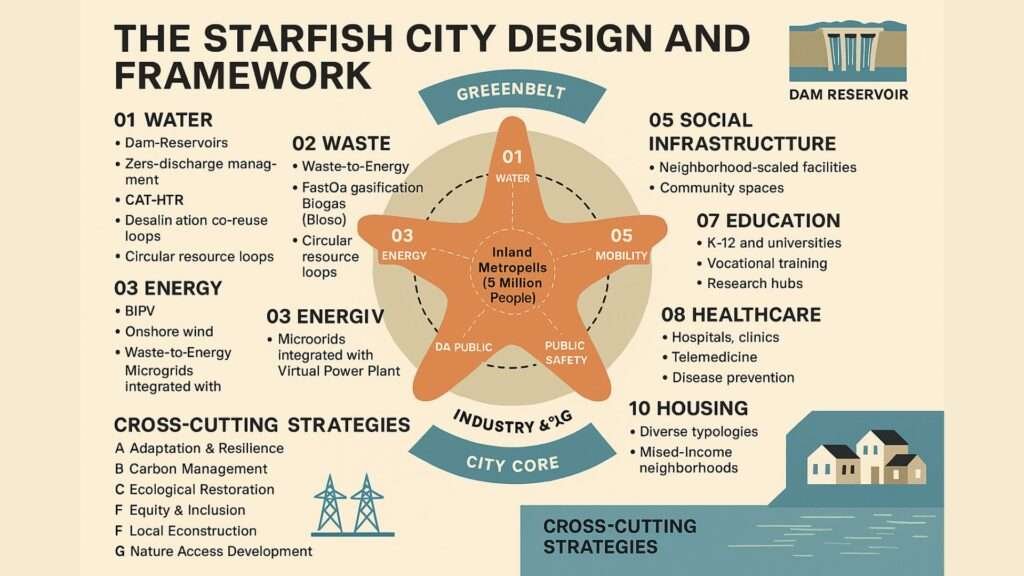
Beyond individual systems, Starfish City’s long-term success depends on cross-cutting frameworks that tie together regulation, operations, finance, culture, and innovation.
Below are eleven critical domains to embed from day one.
11.1 Regulatory & Land-Use Framework
· Define zoning overlays for mixed-use, industrial, conservation, and cultural precincts.
· Secure water rights, native-title agreements, and environmental approvals.
· Establish value-capture legislation and heritage co-management with Traditional Owners.
11.2 Asset Lifecycle & Operations
· Develop O&M roadmaps for dams, desal plants, transit fleets, and digital systems.
· Structure performance-based contracts with clear SLAs and KPIs.
· Plan spare-parts logistics, maintenance depots, and workforce training pipelines.
11.3 Risk Management & Insurance
· Procure climate-risk coverage (flood, fire, drought) and business-continuity insurance.
· Embed cyber-insurance and rapid-response protocols for digital infrastructure.
· Establish a risk-governance committee to oversee scenario planning and drills.
11.4 Monitoring, Evaluation & Continuous Improvement
· Implement quarterly performance reviews against a unified KPI dashboard.
· Commission independent third-party audits and publish scorecards publicly.
· Use adaptive management loops to refine systems based on data insights.
11.5 Finance & Revenue Models Beyond Capex
· Design operating-cost recovery via user-fees, utility tariffs, and subscription services.
· Leverage land-value capture, tax increment financing, and special-purpose levies.
· Explore service concessions and revenue-sharing models with private partners.
11.6 Supply Chain & Procurement
· Map critical inputs (CAT-HTR units, PV panels, battery cells) and diversify suppliers.
· Prioritize local sourcing to build regional capacity and reduce transport emissions.
· Embed ethical procurement standards and resilience criteria in all contracts.
11.7 External Connectivity & Regional Integration
· Integrate high-speed rail, regional airports, and inland port facilities into city logistics.
· Coordinate with state and national freight corridors for efficient exports.
· Position Starfish City as a hub linking rural producers with national markets.
11.8 Cultural & Creative Placemaking
· Allocate arts districts, festivals, and conference venues as economic and social anchors.
· Curate public art, storytelling installations, and heritage trails celebrating local culture.
· Support creative-industry incubators to spur community engagement and tourism.
11.9 Health, Wellbeing & Social Equity Metrics
· Track homelessness reductions, mental-health service uptake, and aged-care coverage.
· Monitor income inequality, digital-inclusion rates, and gender equity indicators.
· Report progress through a public wellbeing dashboard to guide social policy.
11.10 Stakeholder Engagement & Change Management
· Maintain ongoing dialogue with Indigenous groups, local councils, NGOs, and businesses.
· Use citizen feedback loops, conflict-resolution protocols, and change-champion networks.
· Ensure transparency through virtual town halls, advisory committees, and participatory budgeting.
11.11 R&D, Innovation & Knowledge Sharing
· Host living-lab programs in partnership with universities and tech firms.
· Develop the open-source “Starfish Toolkit” for global replication of modular systems.
· Convene an international learning alliance to share data, lessons learned, and best practices.
Section 11 Conclusion:
Embedding these eleven cross-cutting considerations transforms Starfish City from a visionary plan into a resilient, investible, and socially rooted reality.
By uniting regulation, operations, finance, culture, and innovation, the city can adapt, thrive, and inspire a new era of regenerative urbanism. The Starfish Template For Cities begins where conventional urbanism leaves off.







